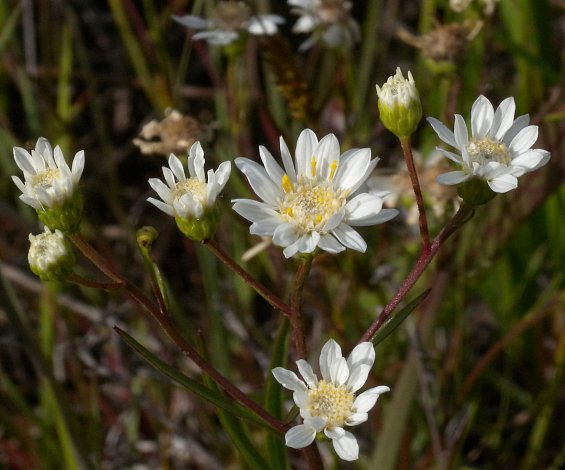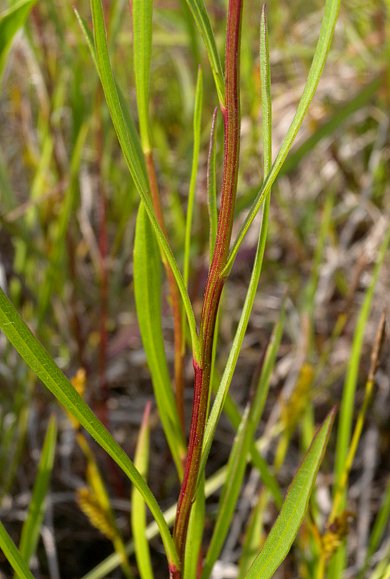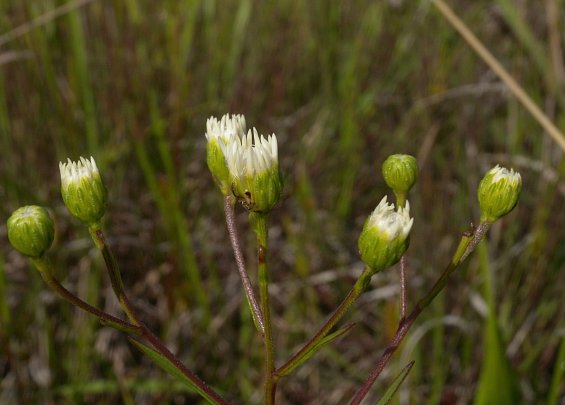
Each flowerhead spans about ¾–1" across, consisting of 10-25 pistillate ray florets that surround numerous perfect disk florets. The petaloid rays (ligules) are widely spreading, elliptic or oblong-elliptic in shape, and bright white; sometimes they are slightly notched at their tips. The corollas of the disk florets are about 4 mm. long, short-tubular in shape, 5-lobed, and dull white; their conjoined stamens are yellow. The base of the flowerhead is surrounded by appressed phyllaries (floral scales) that are arranged in about 4 overlapping series. These phyllaries are about 4 mm. long, linear-oblong to oblong in shape, light to medium green, and glabrous; their margins are a deeper shade of green above than below. The blooming period occurs from mid-summer to early autumn, lasting about 1-2 months for a local population of plants. Afterwards, the flowerheads become light brown and their florets are replaced by small achenes with white tufts of hair. Individual achenes are about 1-1.5 mm. long, bullet-shaped, and glabrous; their apices are truncate where the tufts of hair occur. The root system consists of a branching caudex.
Cultivation: The preference is full sun, moist to dry conditions, and calcareous barren ground that is sandy, gravelly, or rocky. This plant can be cultivated in rock gardens.

Range & Habitat: The native White Goldenrod is uncommon in northern Illinois and sandy areas of mid-central Illinois, while in the rest of the state it is rare or absent (see Distribution Map). Habitats include hill prairies, gravel prairies, sand prairies, and moist sand flats (pannes) along Lake Michigan. Other habitats outside of Illinois include alvars (limestone pavements) along the Great Lakes, rocky cliffs, rocky crevices, river outcrop prairies, sandy Jack Pine plains, and fens. This plant is found in high quality natural areas.
Faunal Associations: Very little is known about floral-faunal relationships for this species. A rare butterfly, Karner's Blue (Lycaeides melissa samuelis), a rare skipper, Poweshiek Skipperling (Oarisma poweshiek), and the common Pennsylvania Soldier Beetle (Chauliognathus pennsylvanicus) have been observed to visit the flowerheads of White Goldenrod (Oligoneuron album); see Grundel & Pavlovic (2000), Semmler (2010), and Williams (2006). The butterfly and skipper feed on nectar, while the soldier beetle probably feeds on pollen. Many other insects undoubtedly visit its flowerheads as well.

Photographic Location: A moist sand flat near Lake Michigan at Illinois Beach State Park in NE Illinois.
Comments: This goldenrod is very unusual because it looks like an aster, and it was even classified as an aster, Aster ptarmicoides, for many years. Other scientific names of White Goldenrod (Oligoneuron album) include Solidago ptarmicoides and Unamia alba. In spite of its deceptive appearance, it was discovered that this species forms naturally occurring hybrids with such flat-topped goldenrods as Oligoneuron rigidum, Oligoneuron riddellii, and Oligoneuron ohiense. In contrast, there is no evidence that it can form hybrids with other goldenrods (Solidago spp.) and asters (Aster spp.). Several common names have been used to refer to this plant, including Prairie Goldenrod, Stiff Aster, Stiff Goldenrod (also used for Oligoneuron rigidum), White Upland Aster, White Upland Goldenrod, and White Flat-topped Goldenrod.